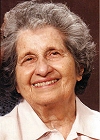Ruth Aaronson Bari

November 17, 1917 - August 25, 2005
Ruth Bari earned a Master's degree at John Hopkins in 1943 but because of work and family responsibilities, did not complete her Ph.D. until 1966. Her dissertation was on "Absolute reducibility of maps of at most 19 regions" [Abstract]. She taught at George Washington University until her retirement in 1988. Her work in graph theory has been recognized as influential, especially in the area of chromatic polynomials. One of her three daughters is Gina Kolata, one of the nation's best known science journalists covering mathematics and science for the New York Times. Following is an essay about her mother that Gina Kolata graciously agreed to write for this web site in 1997. Ruth Bari died in 2005 of complications from Alzheimer's disease.
By Gina Kolata
My mother, Ruth Bari, does not have a computer in her house--and she never uses one. She does not have e-mail; she has never surfed the internet. And she prefers printing the abstracts she still writes for Mathematical Reviews, with her careful slanting handwriting, to typing them on a typewriter.
But although times have changed and technology has invaded our world, my mother's story has resonance still. It shows, I believe, how a passion for mathematics, along with an inborn gift for the subject, can overcome quotidian obstacles.
Mathematics always came easily to my mother. When she was in high school in Brooklyn, she effortlessly got a nearly perfect score on the New York Regents exam, a tough test designed to weed out the talented from the mediocre. But she knew nothing of the depths of the subject. She honestly believed that mathematics ended with calculus.
At Brooklyn College, she learned otherwise, and after taking a course in abstract algebra, she fell in love with the beauty and purity of the subject and decided to major in mathematics. In fact, after graduating from college, she even decided to get a Ph.D., enrolling in a doctoral program at Johns Hopkins University.
But the end of World War II changed her plans. The women in the graduate program were asked to give up their fellowships so that the men, returning from the armed forces, could continue their studies, and my mother complied, leaving Johns Hopkins with a master's degree.
She spent the next period of her life raising me and my two sisters, encouraging us to find a subject that enthralled us and to pursue it, paying no heed to whether there would be a job for us at the end of our studies. Although I suspect she would have been delighted if one of us had become a mathematician, none of us had her talent. But she supported us with no reservations in the fields we did select. I became a journalist at the New York Times, my sister Judi became an environmental activist with Earth First and Martha became an art historian.
When I was in high school, my mother decided to fulfill her dream and get a Ph.D., in mathematics. She applied to Johns Hopkins, which admitted her provisionally. She had to re-do the course work for a master's degree, both to show she could still do mathematics and to make sure she had the preparation she would need for her doctoral research. She did it--working in the wee hours of the night when the house was quiet and no one would interrupt her. Then she went on to get a Ph.D. She was 47 years old.
Her thesis, I'm told, was extraordinary. Shortly after she got her degree, William Tutte, a renowned mathematician in her field, invited her to spend two weeks in his department at the University of Waterloo in Canada, lecturing on her work. He paid all of her expenses and gave her $500 a week, which, my father reminds me, was quite a lot of money in those days.
The next task was to find a job as an academic. My mother only applied to universities in the Washington, D.C. area, where we lived. But it was a halcyon time for academics and she had job offers from nearly every school she applied to. She selected George Washington University and in a few years, as a testament to her research, she was promoted to full professor. She remained there for the rest of her career, teaching and doing research until she was forced by the law at the time to retire at age 70.
My mother loved every aspect of academic life. I asked her more than once if she ever got bored teaching the same subjects over and over. Oh no, she would say. Every class is different.
And my mother relished her life as a researcher. Every graduate student was a pleasure, every conference an honor and a joy. She has delighted in her life, and seized opportunities as they arose, even if it meant getting a Ph.D. at an age when most academics are already full professors. Could every woman who likes mathematics pull this off? I doubt it. But, as my mother would be sure to tell you, in her romantic way, what matters most is that you follow your heart.
References
- Fasanelli, Florence D. "Ruth Aaronson Bari," in Women of Mathematics: A Biobibliographic Sourcebook, Grinstein and Campbell, Editors, Greenwood Press, 1987, 13-16.
- Obituary, Washington Post, Tuesday, August 30, 2005; Page B05.
- Author Profile at zbMath
- MathSciNet [subscription required]
- Mathematics Genealogy Project
